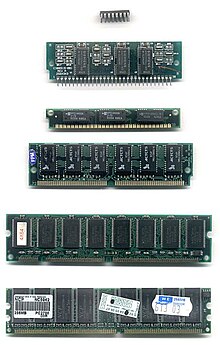Semiconductor memory
A semiconductor memory is a data memory that consists of a semiconductor .
Microelectronic memory structures are implemented in and on a semiconductor crystal so that a memory chip (see also Die ) is created. The chips are completed to form integrated circuits or processed further without caps.
The data are stored in the integrated circuits in the form of binary electronic switching states . Its predecessors were the magnetically operating core memories , which were not replaced by semiconductor memories until the early 1970s. More recent developments aim to combine the magnetic storage principle microelectronically into high-density, non-volatile memories ( MRAM ).
Storage cell
description
A memory cell is the physical realization of the smallest unit of a memory of logical states. The term depending on the context, either the realization of the smallest unit, the 1- bit - storage element , or the realization of the smallest addressable , that is in an access readable or writable, unit, a so-called word or data word consisting of n bits exists (n> 1).
Nowadays, personal computers work with a word length (also called “word width”) of 32 or 64 bits. In the past, for example in the first pocket calculators , memory cells were 4 bits (a half-byte or nibble ) in size. The first PCs, on the other hand, had 8-bit wide memory cells. For simple controls (see: Microcontroller ) 8 bits are still used today.
Word widths of 6 or 7 bits were also used in earlier computers , since alphanumeric processing could be carried out with 64 or 128 storable characters . However, these memories were not yet implemented as semiconductor memories. The Hollerith punch card had a word length of 12 bits.
The memory cells are divided into volatile and non-volatile memory cells. The information is permanently retained in non-volatile memory cells, even if the power supply is interrupted. In the case of volatile memory cells, the information is lost in such a case.
realization
The 1-bit memory element can be implemented using fewer transistors and capacitors . In the case of analog memory cells, the elementary memory component is the capacitor, and in the case of digital memory cells, one (1-T DRAM ) or more transistors are required, e.g. B. with static RAM or with feedback transistors, the so - called flip - flops .
Random access
Memory cells are arranged in a 2 R × 2 C matrix. The memory cells are addressed and written to or read out via word lines and bit lines. A row and a column decoder are required for this. This enables direct access to any memory cells ( random access ). Therefore this arrangement is called Random Access Memory (RAM).
Sequential access
Addressing takes place here using commands, similar to hard drives . The CompactFlash (CF) and PCMCIA designs use e.g. B. the tried and tested ATA / ATAPI command set for hard disks .
This type of addressing requires fewer contact areas on the chip, making it cheaper to manufacture.
See also: memory card , sequential access
Semiconductor memory types
|
|
1 A PLE corresponds to an MROM and vice versa
2 Microcontrollers with MROM are still produced in large numbers (as of the end of 2008).
|
| abbreviation | meaning |
|---|---|
| R.A.M. | Random Access Memory |
| ROME | Read-only memory |
| SRAM | Static RAM |
| DRAM | Dynamic RAM |
| PRAM | Phase-change RAM |
| MRAM | Magnetoresistive RAM |
| M ... | Mask programmed |
| P… | Programmable |
| EP ... | Erasable and programmable |
| EEP ... | Electrically erasable and programmable |
| SD | Synchronous Dynamic (RAM) |
| GDR | Double data rate (RAM) |
| QDR | Quad Data Rate (RAM) |
| ODR | Octo Data Rate (RAM) |
| GDDR | Graphics DDR (RAM) |
| RDRAM | Rambus DRAM |
| E.g. SRAM | Zero Bus turnaround SRAM |
| in production | |
| production stopped | |
| in development |
Sales figures
The following table gives an overview of the different memory types (the sales figures given relate to the year 2005 and are taken from the Elektronik Scout 2006; SRAM does not stand for SRAMs contained in processors.):
| Storage technology | sales | ||
|---|---|---|---|
| Volatile memory (RAM) | |||
| Static RAM ( SRAM ) | $ 2 billion | ||
| Dynamic RAM ( DRAM ) | $ 27 billion | ||
| Non-volatile memory | |||
| Mature material | Read Only Memory ( ROM ) | $ 2 billion | |
| Flash | NAND | $ 8 billion | |
| NOR | $ 9 billion | ||
| Innovative material | $ 0.01 billion | ||
| Total sales | $ 48 billion | ||
Manufacturer (selection)
- Acer
- Adata
- Corsair
- Crucial
- Cypress Semiconductor
- Elpida Memory ( joint venture between NEC and Hitachi )
- Hewlett-Packard
- Hitachi
- Hynix Semiconductor (formerly Hyundai Electronics)
- IBM
- Infineon
- Kingston Technology
- Micron Technology
- Mitsubishi
- NXP Semiconductors (formerly Philips )
- OCZ Technology
- Samsung Electronics
- Sony
- Toshiba
- Transcend
See also
Web links
- Jürgen Plate: Introduction to data processing systems - 7th storage unit (main memory) . FH Munich.
- Interactive CMOS 6T SRAM CELL
Individual evidence
- ↑ Advances in MRAM technology ( Memento of the original from April 13, 2016 in the Internet Archive ) Info: The archive link was inserted automatically and has not yet been checked. Please check the original and archive link according to the instructions and then remove this notice. . itse-wissen.de. Retrieved September 30, 2010.
